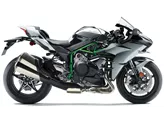Yamaha R1M 2015 vs. Kawasaki Ninja H2 2015

Yamaha R1M 2015

Kawasaki Ninja H2 2015
Overview - Yamaha R1M 2015 vs Kawasaki Ninja H2 2015
In terms of technical specifications, the Yamaha R1M 2015 and the Kawasaki Ninja H2 2015 have some similarities. Both bikes have a 998cc engine with four cylinders and four valves per cylinder. They also have the same front and rear tire width and diameter, as well as the same fuel tank capacity.
However, there are also some notable differences between the two bikes. The Yamaha R1M has a larger bore and stroke, resulting in a slightly higher engine power of 200 HP compared to the Ninja H2's 200 HP. The Yamaha R1M also has a higher torque of 112.4 Nm compared to the Ninja H2's 133.5 Nm. Additionally, the Yamaha R1M has a higher compression ratio of 13 compared to the Ninja H2's 8.5.
In terms of suspension, the Yamaha R1M features an upside-down telescopic fork, while the Ninja H2 has a telescopic fork. The Yamaha R1M also has a frame made of aluminum, while the Ninja H2 has a steel frame. The Yamaha R1M's frame type is Deltabox, while the Ninja H2's frame type is tubular.

Yamaha R1M 2015
Both bikes have double disk brakes at the front, providing strong stopping power. The Yamaha R1M has a wheelbase of 1405 mm, while the Ninja H2 has a slightly longer wheelbase of 1455 mm. The seat height of the Yamaha R1M is 855 mm, while the Ninja H2 has a slightly lower seat height of 825 mm.
In terms of weight, the Yamaha R1M is lighter with a kerb weight of 200 kg compared to the Ninja H2's 238 kg. This lighter weight may contribute to the Yamaha R1M's agility and maneuverability.

Kawasaki Ninja H2 2015
In terms of strengths, the Yamaha R1M is praised for its high-quality hardware components for the chassis and its easy-to-use electronic high-tech suspension from Öhlins. It is also considered a finished racing machine that is still road legal. On the other hand, the Kawasaki Ninja H2 is praised for its outstanding build quality, fascinating engine with a mechanical turbocharger, and its impressive pull, acceleration, and speed. The narrow seat of the Ninja H2 also ensures safe standing, even for smaller riders, and the bike inspires a lot of confidence despite its high performance. The Ninja H2 also has strong brakes and high-quality details.
However, the Yamaha R1M has some weaknesses, including a very limited number of units available and a quickshifter that only supports upshifting. The Kawasaki Ninja H2 has some weaknesses as well, including response behavior in the transition from pushing mode to acceleration phase that is not at the level of "normal" motorbikes, understeer in fast bends, and potential difficulty integrating the feet into the overall aerodynamic concept for riders over 185 cm tall.
Overall, both the Yamaha R1M 2015 and the Kawasaki Ninja H2 2015 are high-performance supersport bikes with their own strengths and weaknesses. The choice between the two would depend on individual preferences and priorities.
Technical Specifications Yamaha R1M 2015 compared to Kawasaki Ninja H2 2015
Pros and Cons in comparison
Pros and Cons in comparison
Yamaha R1M 2015

The Yamaha R1M is a high-priced motorbike. But you don't pay the extra price for worthless bells and whistles, but for a high-quality racing chassis and other tasty details. The R1M is a good choice for those riders who always upgrade their bikes with tuned suspension anyway. In practice, the R1M rides superbly and the ERS system from Öhlins seems tailor-made for it.
Kawasaki Ninja H2 2015

The Ninja H2 represents a milestone in motorbike history. It is not only packed with electronic innovations, but also offers completely new technologies in terms of engine construction and mechanics. This high-tech research object of a Japanese technology company is actually for sale and can also be ridden. Basically, it rides like a normal motorbike, only with considerably more power. At first, the engine response is a challenge, but speed freaks will find a way to ride and enjoy this fascinating motorbike.
Price Comparison Avarage Market Price Yamaha R1M vs Kawasaki Ninja H2
There are a few key differences between a Yamaha R1M 2015 and a Kawasaki Ninja H2 2015. It takes less time to sell a Yamaha R1M with 46 days compared to 153 days for a Kawasaki Ninja H2. Since model year 2015 1000PS.de editors have written 26 reviews for the Yamaha R1M and 27 reviews for the Kawasaki Ninja H2 since model year 2015. The first review for the Yamaha R1M was published on 12/3/2014 and now has more than 9,700 views. This compares to more than 5,600 views for the first review on Kawasaki Ninja H2 published on 8/31/2014.
































